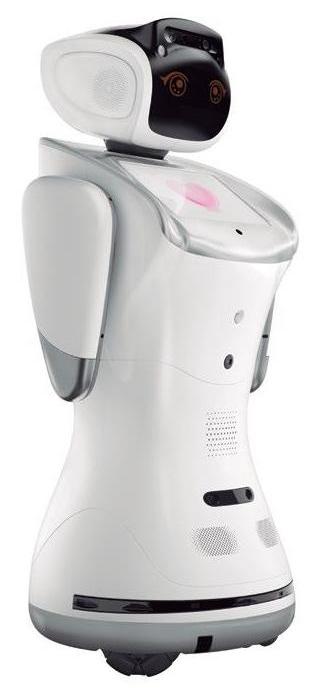
5 minute read
ROBOTS IN THE AGE OF COVID-19
Nothing complicates medical issues like a global pandemic. In recent months, we have seen how ways of interrelating socially have changed, in areas such as health care, the economy, and education, especially in terms of physical distance and health. Before COVID-19, we wouldn’t worry about attending a family get-together and maybe catching a cold, but now we have to be more careful about where we go, and about what we do, touch, or consume. Technology, apart from offering us a comfortable modern lifestyle, has become an ally in the fight against this virus, offering solutions in the various areas that have inevitably been modified.
Throughout the pandemic, patients infected with the disease have filled hospital beds and needed ventilators. As a result, many doctors, nurses, and maintenance workers have not only been directly exposed to the virus, but in some cases have become infected as well. To address this situation, several companies have created assistant robots that help to protect these invaluable members of the workforce.
Advertisement
In Chile, where more than 7,000 people working in the health system have been infected, an assistant robot has been an excellent solution. First of all, it functions as an intermediary between infected patients and the doctors, who might have to see a patient up to twenty times a day. With Eva, the robot, it is possible to have remote interaction by means of its integrated camera and microphone. Secondly, it works as an intermediary between family members and patients, through video calls. Eva was the first robot assistant in Latin America. “She” was manufactured in China, but the company that brought her to her new country was Transformación Digital, an offshoot of PricewaterhouseCoopers (PwC) Chile, under the direction of Rodrigo Palacios. Robots had already been used in European countries and hospitals in Chile were interested in acquiring one after seeing their performance and usefulness. Initially, this robot had been used in the automotive and mining sectors, but the pressure on the hospital system led to its transfer to the health sector. And it has turned out to be highly effective, as it records data from its environment and sends it to the cloud, making not only for better patient monitoring but also improving its own work. Moreover, it can also serve as a security and disinfection robot, and not only for communication purposes. The robot is not yet able to operate on its own: it was introduced into hospitals free of charge as a test, and is expected to improve its functions as time goes by. Machines always tend to replace human beings in various different sectors, but this will certainly not be the case here, since the training of any doctor is incomparably more complex than the possibilities of an android of this type. Nevertheless, it has been of great help to all the medical personnel.

EVA Robot
Elsewhere, in Italy, Tommy, the nursing robot, is one of the six robots that have been acquired to serve as assistants in Italian hospitals. Similar to Eva, Tommy is small and also monitors infected patients. It stands at the patient’s bedside, checks the medical equipment it is in charge of, and sends reports to the hospital staff. It has a touch screen that allows patients to record and send messages to their medical personnel. At first it was difficult to incorporate the robots into the hospital organization, especially among older people, who were reluctant to interact with a machine. But the hospital staff has informed patients that they are each assigned a care robot, explaining how it performs its tasks and how it helps the staff care for everyone. It should be noted that these robots have reduced the number of masks, gloves, and gowns used: this is also beneficial, as it prevents shortages and helps make hospital resources go farther. Tommy has a battery that can be recharged whenever needed, so fatigue is no impediment to continuing to work!

TOMMY Robot
Another robot that has helped, at a time when the world is approaching 70 million cases, is Ninja, which also facilitates patient-doctor communication, but with some variations with respect to the two models described above. Ninja can record temperatures, follow the evolution of symptoms, and program video calls with doctors, allowing them to make assessments. It was created by the Chulalongkorn University in Bangkok and Advanced Info Service, the most important telephone company in Thailand. The robot has 4G technology and was manufactured at a cost of around ten thousand US dollars, but it has been introduced free of charge into hospitals, where it works 24 hours a day.

NINJA Robot
In Mexico, resources of this kind have also been introduced into several hospitals, one of them in San Nicolás de los Garza, Nuevo León, where Temi the robot has been of enormous help. The robot was given the task of visiting patients who are not in critical condition and can interact with it: through video calls, doctors are able to have real-time communication with their patients and can continue evaluating them. The medical staff can manage the robot by remote control, allowing them to review patients’ medication, monitor progress, and address other needs, even from home if necessary. Temi was presented in 2018 at the Internationale Funkausstellung (IFA) Berlin, but has really come into its own in the current circumstances.
REFERENCES:
-Andrea Aguilar Córdoba. “Eva, la robot que ayuda a los medicos en Chile durante la pandemia de COVID-19” (5 June 2020): <https://www.aa.com. tr/es/mundo/eva-la-robot-que-ayuda-a-losm%C3%A9dicos-en-chile-durante-la-pandemia-decovid-19/1866789#> -Agencia Reuters. “Tommy, el robot enfermero que ayuda a doctores italianos a salvar vidas del coronavirus” (1 April 2020): <https://www. elcomercio.com/tendencias/tommy-robot-ayudamedicos-italia.html> -RTVE. “Mapa del coronavirus en el mundo: casos, muertes y los últimos datos de su evolución (25 March 2021):<ttps://www.rtve. es/noticias/20201211/mapa-mundial-delcoronavirus/1998143.shtml> -DW Made for minds. Robots y covid: México (12 November 2020): <https://www.dw.com/es/robotsy-covid-m%C3%A9xico/av-55576251>
Laura Belén Cuevas
has a degree in Hispanic Literature from the University of Guadalajara, a diploma in teaching skills from the University of Guadalajara, has published chronicles, articles and stories in various publications, and currently serves as a high school teacher teaching all units of learning Spanish and art.








